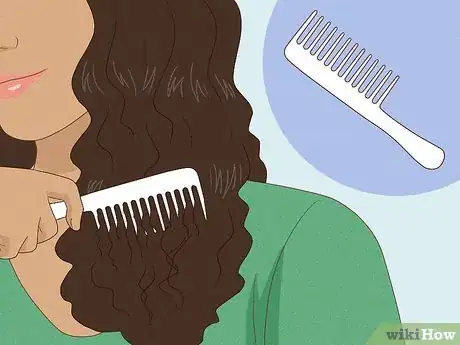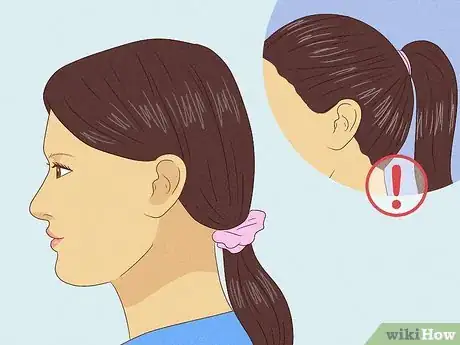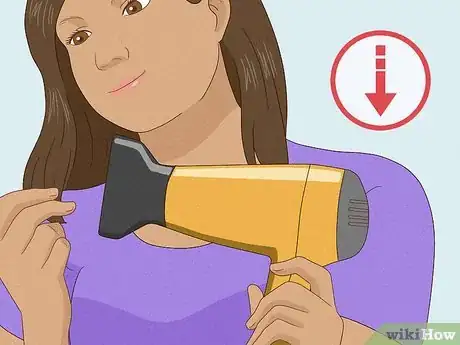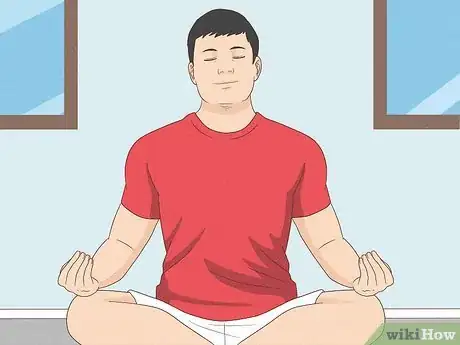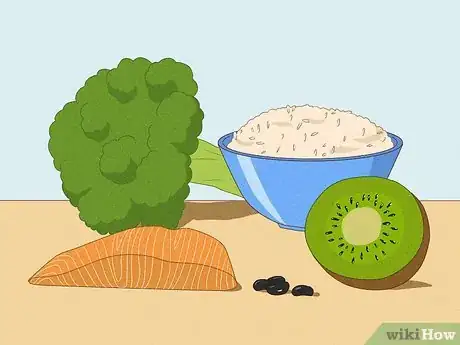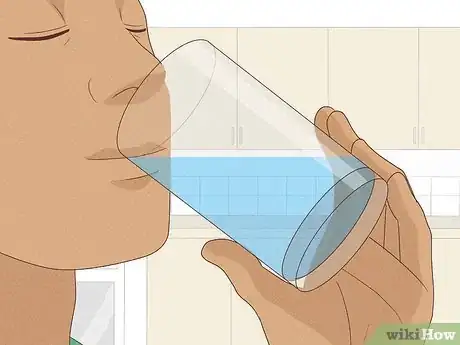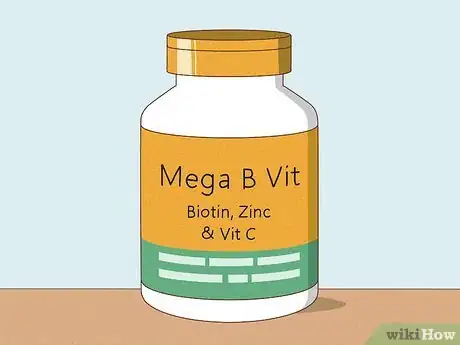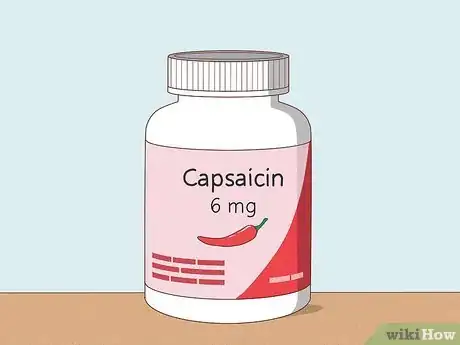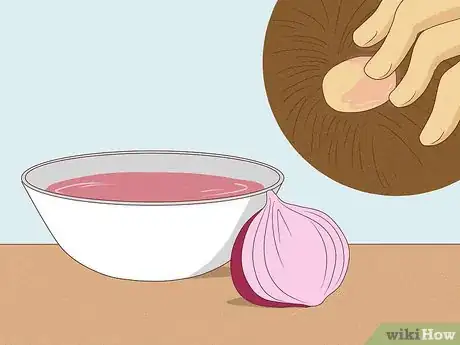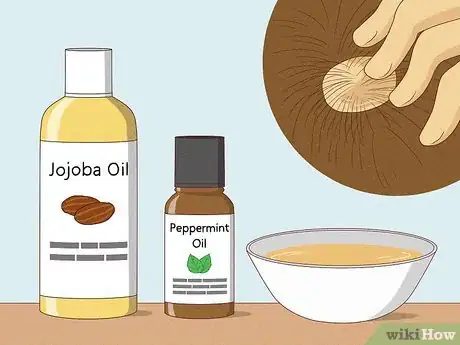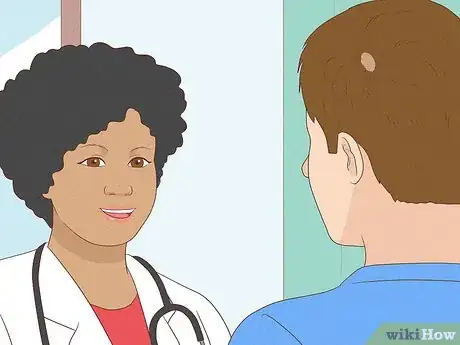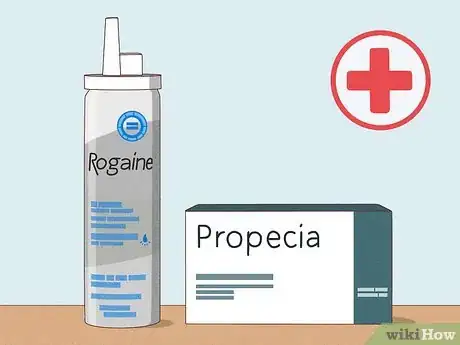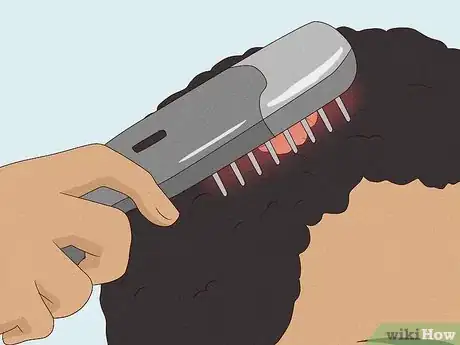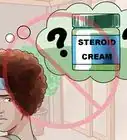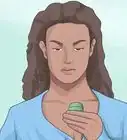This article was medically reviewed by Erik Kramer, DO, MPH and by wikiHow staff writer, Christopher M. Osborne, PhD. Dr. Erik Kramer is a Board-Certified Primary Care Physician at the University of Colorado. With over 15 years of experience, his clinical interests include obesity and weight management, diabetes care, and preventive care, as well as embracing a holistic approach to primary care. He received his Doctorate in Osteopathic Medicine (D.O.) from the Touro University Nevada College of Osteopathic Medicine and completed his residency at Central Maine Medical Center. Dr. Kramer is a Diplomate of the American Board of Obesity Medicine.
There are 19 references cited in this article, which can be found at the bottom of the page.
wikiHow marks an article as reader-approved once it receives enough positive feedback. In this case, 89% of readers who voted found the article helpful, earning it our reader-approved status.
This article has been viewed 985,802 times.
Hair loss is very common—hormonal changes, medical conditions, and new medications can all cause it, or there might be no particular reason beyond your heredity. But that doesn’t mean you have no choice but to sit back and let it happen! This article lists several helpful strategies for reducing hair loss, starting with hair care and lifestyle changes, moving on to home remedies that may be effective, and finishing with medical treatments for active hair loss.
Steps
Wash and dry your hair gently.
-
Scrubbing and rubbing can cause individual hairs to fall out. Be nice to your hair and it’ll be more likely to hang around![1] X Research source Wash your hair with warm water, not hot, and massage the shampoo in gently with your fingertips. If possible, let your hair air dry. Otherwise, dry it with a soft towel by wrapping it or patting and lightly squeezing it, not by vigorously rubbing it.[2] X Research source
Work out tangles with a wide-tooth comb.
-
Avoid the urge to yank out knots and tangles. Harsh methods of yanking out tangles also end up yanking out healthy hairs. Instead, use a wide-tooth comb or brush and gently work it through the tangle until it loosens up.[3] X Trustworthy Source American Academy of Dermatology Professional organization made of over 20,000 certified dermatologists Go to source
- Reduce your likelihood of getting tangles by applying a leave-in conditioner or detangler spray after each bath or shower.
Limit your use of tight-pulled hairstyles.
-
Hairs that are repeatedly pulled tight are more likely to fall out. Tight ponytails, buns, pigtails, cornrows, and braids can cause a condition called traction alopecia—which is basically when individual hairs start to fall out from being pulled too tight for too long. Use these hairstyles only sparingly and opt for more relaxed hairstyles the rest of the time.[4] X Trustworthy Source American Academy of Dermatology Professional organization made of over 20,000 certified dermatologists Go to source
- Traction alopecia can eventually lead to permanent hair loss in the affected areas.
Minimize harsh hair treatments.
-
Use heat sources and chemical treatments on your hair sparingly. Hot blow dryers, curlers, irons, and combs strip moisture from your hair and weaken the individual strands. Similarly, chemical treatments like perms, straighteners, relaxers, and colorants can significantly weaken your hair. Save such treatments for special occasions, not for frequent use.[5] X Trustworthy Source American Academy of Dermatology Professional organization made of over 20,000 certified dermatologists Go to source
- Avoid do-it-yourself chemical treatments. Instead, let trained professionals do the job for you.
Find ways to reduce your stress.
-
Having high stress levels can lead to particular types of hair loss. It feels like a vicious cycle: hair loss can cause stress, and excessive stress can cause hair loss. But you can help break the cycle by managing your stress levels. Try meditating, taking long walks, doing yoga, breathing deeply, journaling, or doing whatever other healthy activities work as stress-busters for you. Reducing your stress can help control the following types of hair loss:[6] X Research source
- If you have telogen effluvium, significant stress pushes large numbers of hair follicles into a resting phase. Within a couple months, affected hairs fall out suddenly when you comb or wash your hair.
- With trichotillomania, you have an irresistible urge to pull hair from your scalp, eyebrows or other areas of your body. You might do this to deal with stress, tension, loneliness, boredom, or frustration.
- Stress also can cause patchy baldness (alopecia areata). With this condition, your immune system attacks your hair follicles, which causes hair loss.
Eat a healthy, protein-rich diet.
-
Nourish your hair along with the rest of your body. Eating a nutritionally balanced diet keeps your hair healthy and resilient. Aim to increase your intake of fruits and vegetables, whole grains, lean proteins, and healthy fats, and cut back on processed foods, saturated fats, and added sugars.[7] X Trustworthy Source American Academy of Dermatology Professional organization made of over 20,000 certified dermatologists Go to source
- Eating more protein may be particularly beneficial for preventing hair loss. Choose healthy protein sources like fish, poultry, beans, and nuts, and use a reputable online nutrient calculator to determine how much protein you should consume per day.[8] X Research source
- Consuming more iron may also help prevent hair loss. Choose healthy high-iron foods like beans, peas, dark leafy greens, poultry, seafood, and fortified whole grains, and use a nutrient calculator to determine your ideal iron intake.[9] X Research source
Drink water to hydrate your hair.
-
Hydrated hair is healthier and may stick around longer. There are lots of unproven claims online about how drinking more water will prevent hair loss. There's little specific evidence to support these claims, but it's true that your hair follicles do contain water[10] X Research source and that proper hydration is critical to your overall health.[11] X Research source So drink up!
- How much water should you drink? There's the old standby of 8 cups (approx. 2 L) per day, as part of a total goal of around 15 cups (approx. 3.5 L) of total fluids (from food and drink) per day for an adult male.[12] X Research source In reality, though, if you "obey your thirst" and drink water whenever you start to feel thirsty, you should stay properly hydrated.[13] X Research source
- Plain water and mineral water are the best hydration choices. Otherwise, opt for low-calorie, low-sugar beverages. It also helps to eat water-rich fruits and vegetables like melons, berries, peppers, and cucumbers.
Take a daily multivitamin with 3 mg of biotin.
-
Biotin, a B vitamin, may help prevent hair loss. Biotin supplements have long been promoted as a hair loss treatment, even though there is still limited clinical evidence that this B vitamin has any clear hair loss benefit.[14] X Trustworthy Source PubMed Central Journal archive from the U.S. National Institutes of Health Go to source That said, the anecdotal evidence is strong and the downsides are small when biotin is taken as part of a high-quality multivitamin. Try taking a daily “mega-B vitamin” combination supplement that includes the following: 3 mg of biotin; 30 mg of zinc; 200 mg of vitamin C; and up to 1 mg of folic acid.[15] X Trustworthy Source Cleveland Clinic Educational website from one of the world's leading hospitals Go to source
- Biotin is also found in foods like eggs, fish, meat, seeds, nuts, sweet potatoes, broccoli, and cauliflower.
- Talk to your doctor before taking higher doses of biotin supplements.
- Nutritional supplements that contain high doses of selenium, vitamin A, or vitamin E may actually cause hair loss—even if they’re marketed for hair loss prevention! Just like with higher-dose biotin supplements, talk to your doctor first before trying them.[16] X Trustworthy Source American Academy of Dermatology Professional organization made of over 20,000 certified dermatologists Go to source
Give capsaicin supplements a try.
-
A daily 6 mg capsaicin tablet may help control hair loss. Capsaicin, the compound in peppers that gives them their heat, seems to stimulate hair growth. It’s not proven that oral capsaicin supplements work, but to try them, take a single 6 mg tablet per day for at least 5 months. Choose a high-quality capsaicin supplement from a well-known source.[17] X Trustworthy Source PubMed Central Journal archive from the U.S. National Institutes of Health Go to source
- Capsaicin supplements are generally safe but may irritate your digestive tract—just like if you eat too many spicy peppers!
Apply onion juice on thinning patches.
-
Onion juice may help treat patchy hair loss (alopecia areata). This sounds like one of those very questionable home remedy treatments you stumble across online, but there is some evidence that this one works! The evidence indicates that it’s only effective at treating patchy hair loss (alopecia areata), not male or female pattern baldness—but it may be worth a try in any case. Either buy onion juice or make your own and do the following:[18] X Trustworthy Source PubMed Central Journal archive from the U.S. National Institutes of Health Go to source
- Chop an onion into fine pieces.
- Squeeze out the juice with a hand juicer or a juicer machine.
- Massage the juice into your bald patches, then leave it for about 15 minutes.
- Gently wash your hair as needed.
- Repeat twice per day. You may start to see results after 2 weeks, or it may take up to 8 weeks of treatment to get any results.
Massage your scalp with diluted peppermint oil.
-
Try this natural treatment on areas of patchy hair loss. Choose a carrier oil like jojoba or coconut oil and add a small amount—roughly equal to the amount of shampoo you use in your hair—to a small bowl. Add 2-3 drops of pure peppermint oil (3% concentration) and stir the mixture with your fingers. Massage the oil into your thinning hair once per day for at least 4 weeks, preferably in the evening so it can stay in your hair overnight.[19] X Trustworthy Source PubMed Central Journal archive from the U.S. National Institutes of Health Go to source
- Peppermint oil has anti-inflammatory properties, but it’s not completely understood how it may promote hair growth.
- A few drops of peppermint oil may not seem like much, but it’s potent stuff! Resist the urge to use undiluted peppermint oil—it can cause a strong burning sensation and scalp irritation.
- This treatment is likely to be more effective for patchy baldness (alopecia areata) as opposed to male or female pattern baldness.
- You can find 3% peppermint oil (as well as jojoba and coconut oils) in health and wellness stores, some grocery stores, and online. Be sure to choose high-quality products from reputable manufacturers.
Share your concerns with your doctor.
-
They can help if you're experiencing hair loss or just worried about it. If you’re showing clear signs of hair loss and want a professional diagnosis and treatment plan, see your doctor. Even if you’re not sure you’re losing hair but are feeling worried that you might be, pay your doctor a visit to discuss your situation. They’ll likely do a physical examination, medical history, and family history, and possibly some other diagnostic tests. From there, the two of you can talk about your current situation, your future potential for hair loss, and your particular treatment options.[20] X Research source
- Your doctor may perform a hair pull test to see if you have active hair loss. This involves grabbing 40–60 hair fibers close to the skin and lightly tugging them. If 6 or more hairs pull out easily, then you may have active hair loss.
Take doctor-recommended medications.
-
Try using either minoxidil or finasteride to combat hair loss. In the U.S., the Food and Drug Administration (FDA) has approved two drugs to treat hair loss. The first, minoxidil (Rogaine), is a non-prescription (OTC) liquid or foam that can be used by men and women. Rubbing the product into your scalp 1-2 times per day works to grow new hair and prevent additional hair loss. Finasteride (Propecia) is a prescription drug in once-daily pill form that should be used only by men. Many finasteride users experience slowed hair loss and may have new hair growth. With either drug, you must continue to use the product for the effects to last.[21] X Trustworthy Source PubMed Central Journal archive from the U.S. National Institutes of Health Go to source
- Possible side effects of minoxidil include scalp irritation, undesired hair growth on your face and hands, and a rapid heart rate.
- Some uncommon side effects of finasteride include reduced libido, decreased sexual function, and a higher risk of prostate cancer. Women who are potentially pregnant should not touch broken tablets.
Look into medical hair restoration treatments.
-
Laser therapy or hair transplants may help with hereditary hair loss. If hair loss prevention methods aren’t working for you, talk to your doctor about the following FDA-approved treatment options for male or female pattern baldness:
- Laser therapy. To treat your hair at home with a “laser comb” (available at major retailers for around $200-$500 USD), move the device slowly from the front of your scalp to the back and then from the sides to the center. A beep sounds every few seconds to let you know when to move. Studies indicate that laser combs, when used three times per week, do improve hair growth.[22] X Trustworthy Source PubMed Central Journal archive from the U.S. National Institutes of Health Go to source
- Hair transplant surgery. During this procedure, a cosmetic surgeon will remove small skin plugs, each of which contain a small number of hairs, from an area on your head with full hair coverage. They will then transplant the plugs to your bald spots. It can be costly—around $3,000-$15,000 USD—but carries only a very low risk of complications like scarring or infection.[23] X Research source
You Might Also Like
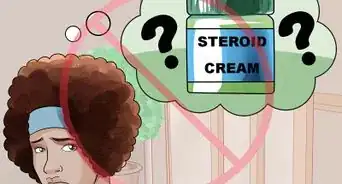


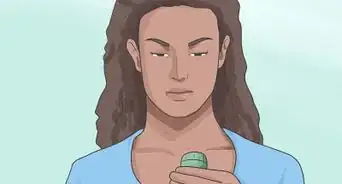
-Step-11.webp)


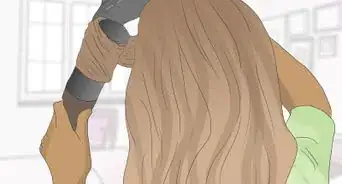
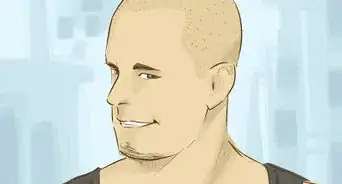

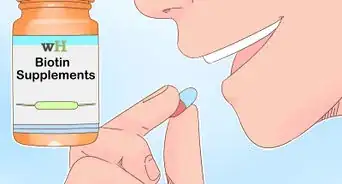


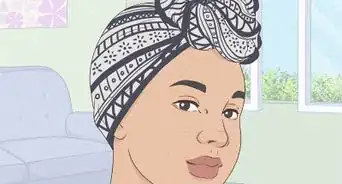
References
- ↑ https://skinkraft.com/blogs/articles/how-to-towel-dry-hair/
- ↑ https://skinkraft.com/blogs/articles/how-to-towel-dry-hair
- ↑ https://www.aad.org/public/diseases/hair-loss/treatment/tips
- ↑ https://www.aad.org/public/diseases/hair-loss/treatment/tips
- ↑ https://www.aad.org/public/diseases/hair-loss/treatment/tips
- ↑ https://share.upmc.com/2018/12/losing-hair-from-stress/
- ↑ https://www.aad.org/public/diseases/hair-loss/treatment/tips
- ↑ https://www.nal.usda.gov/fnic/dri-calculator/index.php
- ↑ https://www.nal.usda.gov/fnic/dri-calculator/index.php
- ↑ https://sites.duke.edu/thepepproject/module-2-drug-testing-a-hair-brained-idea/content-background-the-anatomy-and-composition-of-hair/
- ↑ https://www.hsph.harvard.edu/news/hsph-in-the-news/the-importance-of-hydration/
- ↑ https://www.americanhealthandwellnesscenter.com/should-you-actually-be-drinking-8-cups-of-water-a-day/
- ↑ https://www.bbc.com/future/article/20190403-how-much-water-should-you-drink-a-day
- ↑ https://www.ncbi.nlm.nih.gov/pmc/articles/PMC5582478/
- ↑ https://health.clevelandclinic.org/is-biotin-as-good-as-advertised-for-your-hair-loss/
- ↑ https://www.aad.org/public/diseases/hair-loss/treatment/tips
- ↑ https://pubmed.ncbi.nlm.nih.gov/17569567/
- ↑ http://www.ncbi.nlm.nih.gov/pubmed/12126069
- ↑ https://www.ncbi.nlm.nih.gov/pmc/articles/PMC4289931/
- ↑ https://nyulangone.org/conditions/hair-loss/diagnosis
- ↑ https://www.ncbi.nlm.nih.gov/pmc/articles/PMC4314881/
- ↑ http://www.ncbi.nlm.nih.gov/pubmed/24474647
- ↑ https://www.betterhealth.vic.gov.au/health/conditionsandtreatments/hair-transplant-surgery
- ↑ http://dermatology.columbia.edu/conditions/baldness.html
About This Article

To reduce hair loss, consider natural treatments. For example, sage may increase hair density, and rosemary might stimulate hair growth. Buy these herbs fresh, and cook and eat them weekly for best results. Alternatively, you can directly treat the scalp by mixing rosemary with almond oil and applying it to balding areas 2 to 3 times a week. If you prefer professional treatments, see a doctor to discuss the medications, such as Rogaine, which is applied to the scalp, or Propecia, which is ingested daily. To learn more from our Doctor of Medicine co-author, like how to prevent any further hair loss, keep reading the article!

